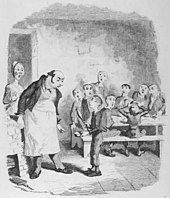Gruel
| Type | Porridge |
|---|---|
| Main ingredients | Cereal meal or flour, water or milk |
| Variations | Congee |
Gruel is a food consisting of some type of
Gruel is also a colloquial expression for any watery food of unknown character, e.g., pea soup.[2][3] Gruel has often been associated with poverty, with negative associations attached to the term in popular culture, as in the Charles Dickens novels Oliver Twist and A Christmas Carol.
History
Gruel was the
In the United Kingdom it was a common remedy for the sick, being relatively nourishing and easy to digest, and a standard component of the evening meal in British hospitals into the early 20th century.[5][6]
In the
Gruel was on the

Variations
In many Spanish-speaking countries, several gruels are made; the masa-based drink or spoonable food called atole or atol de elote is a staple throughout Central America, served hot. It can range in consistency from a thin cloudy drink to a thicker porridge-like food. Horchata is a chilled sweetened drink of similar nature to thin atole. It is made from ground nutmeats or seeds, grains (often rice) and seasonings such as vanilla and cinnamon, served over ice.
Rice gruels eaten throughout Asia are normally referred to in English as porridge as opposed to gruel. Common forms include congee, from the Tamil word for the food and most common in China, Japanese okayu, Korean juk, Filipino goto, and Vietnamese cháo. Asian porridges/gruels are typically savory[citation needed], with meat or vegetables added and stock sometimes used as the liquid cooking element.
Etymology
The
The Old Norse word grautr, meaning "coarse-ground grain", gives way to the Icelandic grautur, Faroese greytur, Norwegian grøt (nynorsk graut), Danish grød, and the Swedish and Elfdalian gröt, all meaning porridge, of which gruel is a subtype.
The German "Grießmehl", ground grain, and Dutch "griesmeel", are compounded cognates to the English grist and meal.
In fiction

In the
References
- ^ A gruel of cornmeal, soaked and cooking in a double-boiler, was recommended for typhus patients in The American Journal of Nursing 14.4 (January 1914) p. 296.
- ^ The word soup is related to sop, the slice of bread which was soaked in broth or thin gruel.
- ^ Maguelonne Toussaint-Samat, Anthea Bell, tr. The History of Food, revised ed. 2009, p. 161.
- ^ Toussaint-Samat 2009, p. 93.
- ^ Edmund Adolphus Kirby (1883). A pharmacopœia of selected remedies. Oxford University. p. 107.
- ^ May Byron (1934). Simple Fare for Sick Folk: recipes for feeding invalids & convalescents. Hodder & Stoughton.
- ^ Oliver Twist, chapter 2.
- ^ There have been many parodies of Oliver Twist; for instance, in The Simpsons episode "Kamp Krusty", Bart and some of the other children are forced to eat "Krusty Brand Imitation Gruel" as their only meal, punctuated by the comment "Nine out of ten orphans can't tell the difference."
